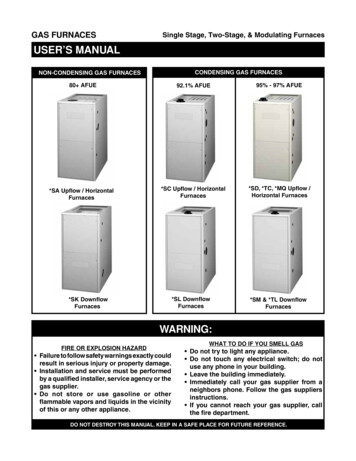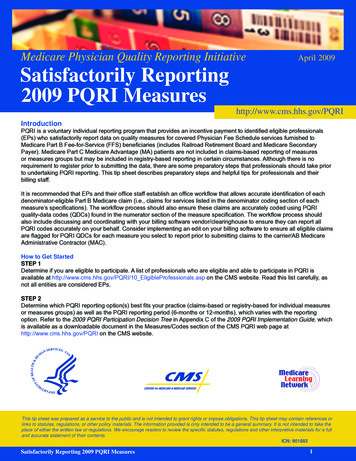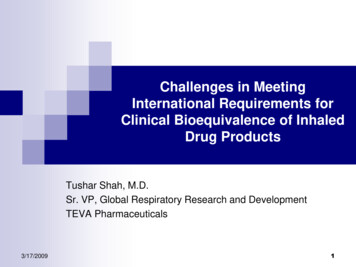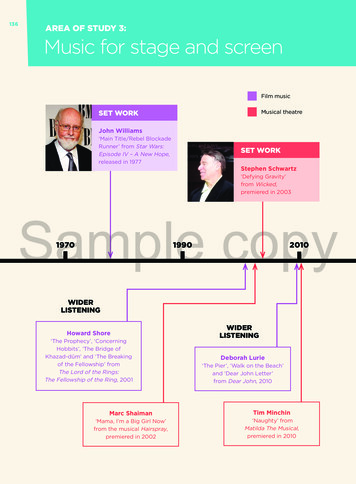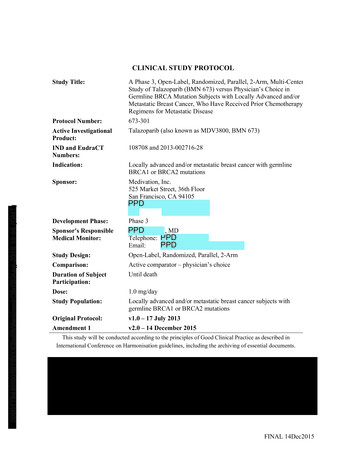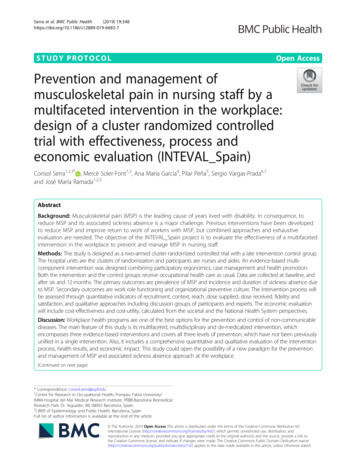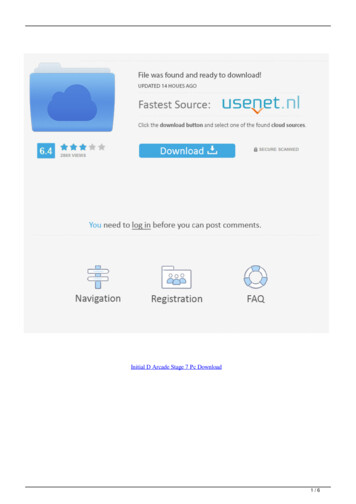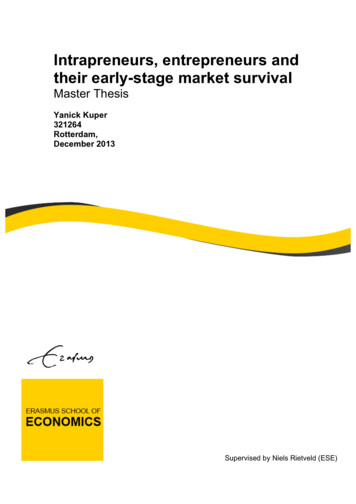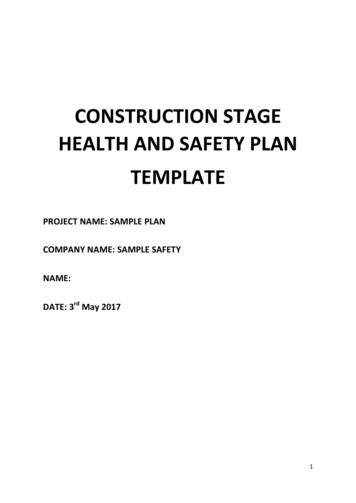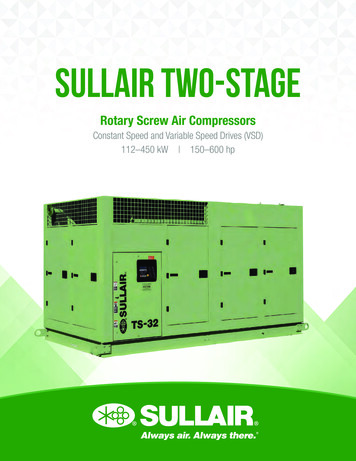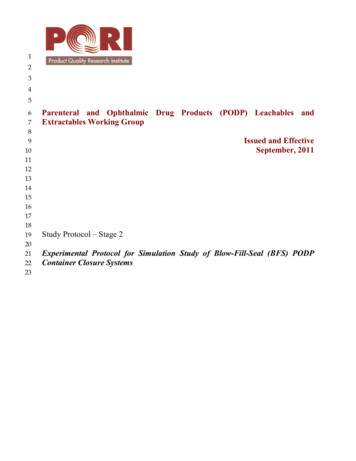
Transcription
1234567891011121314151617181920212223Parenteral and Ophthalmic Drug Products (PODP) Leachables andExtractables Working GroupIssued and EffectiveSeptember, 2011Study Protocol – Stage 2Experimental Protocol for Simulation Study of Blow-Fill-Seal (BFS) PODPContainer Closure Systems
PODPLeachables and Extractables Working GroupExperimental Protocol for Simulation Study, Stage 849505152535455565758596061626364656667Issued and EffectiveSeptember, 2011TABLE OF CONTENTSI.INTRODUCTION3II.PURPOSE AND SCOPE OF WORK (STUDY PROTOCOL STAGE 2)5III.REGULATORY STATUS6IV.SAFETY AND ENVIRONMENTAL IMPACT6V.TEST SYSTEM7VI.CHEMICAL S AND EQUIPMENT7A.B.C.D.8888Extraction SolventsAdditional ChemicalsExtraction EquipmentAnalytical InstrumentationVII. EXTRACTION PROCEDURESA.B.C.9Simulating Extraction SolventsAccelerated Extraction ConditionsExaggerating FactorsVIII. ANALYTICAL METHODSA.B.B.C.E.99910GeneralSystem SuitabilityGas Chromatography (GC)1.General2.Sample Preparation3.Operating Conditions4.General CommentsHigh Performance Liquid Chromatography (HPLC)1.General2.Sample Preparation3.Operating Conditions4.General CommentsHeadspace GC/MS Analysis1.General2.Sample Preparation3.Operating Conditions4.General Comments-1-1010181818222222222222232323232424
PODPLeachables and Extractables Working GroupExperimental Protocol for Simulation Study, Stage 268697071727374757677787980818283F.IX.Inductively Coupled Plasma Atomic Spectroscopy (ICPAS)1.General2.Sample Preparation3.Operating Conditions4.General CommentsIssued and EffectiveSeptember, 20112525252526DATA EVALUATION AND REPORTING26A.B.2626Qualitative AnalysisSemi-Quantitative MeasurementX.GLOSSARY27XI.REFERENCES27-2-
PODPLeachables and Extractables Working GroupExperimental Protocol for Simulation Study, Stage 22123124125I.Issued and EffectiveSeptember, 2011IntroductionIt has been well established that substances extracted by drug products from their containerclosure systems can affect the drug product’s safety and efficacy. Regulatory guidance hasprovided some recommendations regarding the analysis and toxicological safety assessment (i.e.,qualification) of such substances. Thus, for example, the FDA issued Container Closure Systemsfor Packaging Human Drugs and Biologics – Chemistry, Manufacturing and Controls (CMC)documentation Guidance for Industry in May 1999 1 . In addition, the European MedicinesAgency (EMEA) issued its Guideline on Plastic Immediate Packaging Materials in May 2005. 2Specific Guidance for Orally Inhaled and Nasal Drug Products (OINDP) is contained in twoCMC Guidances addressing OINDP1: (i) the draft Guidance for Industry, Metered Dose Inhaler(MDI) and Dry Powder Inhaler (DPI) Drug Products, Chemistry, Manufacturing, and ControlsDocumentation (November, 1998); and (ii) the Guidance for Industry, Nasal Spray andInhalation Solution, Suspension, and Spray Drug Products Chemistry, Manufacturing, andControls Documentation (July, 2002).In September 2006, the Product Quality Research Institute (PQRI) issued a Recommendationentitled “Safety Thresholds and Best Practices for Extractables and Leachables in Orally Inhaledand Nasal Drug Products” 3 . This Recommendation provided a scientific rationale and process toidentify, quantify and establish the biological safety (i.e. qualify) of leachables and/orextractables where appropriate, in OINDP. Included in this Recommendation were experimentalprotocols, and the results thereof, for establishing Best Demonstrated Practices for theperformance of Controlled Extraction Studies, specifically relevant of the OINDP dosage forms.The PQRI Parenteral and Ophthalmic Drug Products (PODP) Leachables and ExtractablesWorking Group is developing, executing and reporting experimental studies as the means ofestablishing Best Demonstrated Practices for the performance of Chemical Assessmentsspecifically relevant for PODP container closure systems and dosage forms. Figure 1, TheChemical Assessment Triad, illustrates the Chemical Assessment Process. The PODP Stage 1study considered the process of Material Characterization; specifically the processes by which aControlled Extract is generated, by which a Controlled Extract is analyzed and by which the testresults are evaluated and interpreted. This Stage 2 study considers the process of performing aSimulation Study, specifically establishing the extractables profile of an experimental containerclosure system constructed from some of the materials that were characterized in the Stage 1study. This experimental container closure system specifically mimics a Blow-Fill-Seal (BFS)packaging system, such as those used with many ophthalmic products, consisting of a BFSbottle, its associated cap, a closure gasket and an affixed printed label.This experimental protocol will be used by all participating laboratories and investigators.1Available .2Available at pdf3Available at http://pqri.org/pdfs/LE Recommendations to FDA 09-29-06.pdf-3-
PODPLeachables and Extractables Working GroupExperimental Protocol for Simulation Study, Stage 5176177Issued and EffectiveSeptember, 2011Figure 1. Generalized Chemical Assessment, The Chemical Assessment Triad. A simulationstudy may be an appropriate and effective bridge between the materialcharacterization process, which establishes extractables that are tentative leachablesand product assessment, which measured confirmed leachables. As the namesuggests, a simulation study seeks to mimic the product assessment by usingsimulating solvents to facilitate the analytical tasks and using extraction conditionswhich accelerate the product contact conditions. The simulation study may be thebasis of a preliminary toxicological assessment and can be used to establish targetleachables to measure during product assessment.Material Screening and SelectionCharacterize candidate and assess theirworthiness for application; extractables aspotential leachablesSimulation StudyWorst case simulation;extractables as probableleachablesProduct AssessmentActual case; measurementof confirmedleachables-4-
PODPLeachables and Extractables Working GroupExperimental Protocol for Simulation Study, Stage 211212213214215216217218219220221II.Issued and EffectiveSeptember, 2011Purpose and Scope of Work (Study Protocol Stage 2)The purpose of the experiments outlined in this protocol is to generate data from a SimulationStudies, which the Working Group will use to investigate its hypotheses:1. Threshold concepts that have been developed for safety qualification of leachables inOINDP can be extrapolated to the evaluation and safety qualification of leachables inPODP, with consideration of factors and parameters such as dose, duration, patientpopulation and product dependent characteristics unique to various PODP types.2. The science-based best demonstrated practices established for the OINDP pharmaceuticaldevelopment process can be extrapolated to PODP container closure systems.3. Threshold and best practices concepts can be integrated into a comprehensive process forcharacterizing container closure systems with respect to leachable substances and theirassociated impact on PODP safety.The Simulation Study will be performed following the general methodologies contained in thisprotocol. The Test System, designed to mimic a Blow-Fill-Seal (BFS) packaging system, will befilled with various simulating extraction solvents which are intended to mimic aqueous PODPdrug products. The Test System will be exposed to accelerated storage conditions that mimic apost-filling shelf life of 2 years at ambient temperature. Consistent with the BFS process, thefilled Test System will not be exposed to terminal or auxiliary sterilization. At certain timesduring accelerated storage, the simulating extraction solvents will be characterized to revealorganic and inorganic extractables, thus establishing the Test System’s Extractables Profile. Theintent of this Stage 2 assessment is to generate the fundamental information from which BestDemonstrated Practices can be derived; it is not the intent of this Stage 2 assessment toprospectively establish the practices used in this study as the Best Demonstrated Practicesthemselves. It can be reasonably expected that this Extractables Profile will include tentativeextractables revealed in the Stage 1, Material Characterization, study,As no single analytical technique can be used to identify and quantify all extractables, a varietyof methods will be utilized in this protocol to maximize the likelihood that all predominantextractable compounds associated with the test articles are accounted for and appropriatelyevaluated. Overlap between methods will supply corroborating data that demonstrate the validityof the procedures. To provide a full analytical survey of possible analytes the following strategywill be employed:1.2.Gas Chromatography with appropriate sampling/injection and detection strategiese.g. Flame Ionization Detection (GC/FID) and Mass Spectrometry (GC/MS)] foridentification and assessment of volatile and semi-volatile extractables.High Performance Liquid Chromatography with appropriate detection strategies[e.g. Diode Array Detection (HPLC/DAD), Mass Spectrometry (LC/MS)] foridentification and assessment of relatively polar and non-volatile extractables.-5-
PODPLeachables and Extractables Working GroupExperimental Protocol for Simulation Study, Stage 2552562572582592602612622632642652663.4.Issued and EffectiveSeptember, 2011Gas chromatography with headspace sampling (HS-GC) for identification andassessment of volatile extractables.Inductively Coupled Plasma/Mass Spectrometry (ICP/MS) and/or InductivelyCoupled Plasma/Atomic Emission Spectroscopy (ICP/AES) to detect singleelements in the extracts (i.e. metals).While analytical tests and measurements, such as pH, UV absorbance, and total organic carbon(TOC), can provide insight into the general chemical nature and amount of extracted substances,they do not directly provide information for the identification and/or quantitation of individualextractables and thus will not be utilized in this study.Studies designed to assess recovery (i.e. mass balance) for individual extractables relative to theknown formulations of chemical additives in the various test articles, or reproducibility ofextractables profiles for multiple “batches” of any particular test article are not within the scopeof this Stage of the test protocol. Additionally, the extraction procedures, analyticaltechniques/methods, and analysis conditions described in this experimental test protocol will notbe fully and rigorously validated. Nevertheless, the scientific credibility of the data generated inthis study shall be established via the utilization of system suitability testing with all the analysismethods and by the expert review of the generated data. Finally, “special case” classes ofextractables that have defined and highly specific analytical methods that are generally acceptedand commonly used for their identification and quantitative assessment will not be considered inthis study.III.REGULATORY STATUSThis experimental test protocol will be conducted in the spirit of Good Laboratory Practices andGood Manufacturing Practices (GXP) requirements. All experiments shall be documented basedon the appropriate GXP compliance systems in a participating laboratory. Any changes orclarifications that a participating laboratory makes to this test protocol shall be documented asappropriate, and discussed/approved by the Study Coordination as appropriate.IV.SAFETY AND ENVIRONMENTAL IMPACTChemicals and reagents used in this study (e.g. organic solvents commonly used to enhancesolubility of lipophilic targets and to increase transport of small molecules out of complexmatrices) may be flammable and/or pose short-term and long-term environmental health risks.Care must be exercised with their use. Consult the Material Safety and Data Sheet (MSDS) forappropriate personal protection and disposal. Safety risks associated with the various processesand procedures performed in this study may exist and should be understood and managed usingsuch strategies as environmental control and personal protection.V.TEST SYSTEMThe Test System is designed to mimic a Blow-Fill-Seal (BFS) packaging system, such as that usedfor ophthalmics and small volume parenterals (SVP). In general such a system consists of the-6-
PODPLeachables and Extractables Working GroupExperimental Protocol for Simulation Study, Stage 2267268269270271272273274275276277278279BFS container (in this case a bottle), one or more closures (in this case the bottle’s associated capand a gasket/liner) and some type of labeling (in this case a printed label). Due to procurementlimitations and confidentiality issues, a Test System that truly represents commercial BFSpackaging systems was not obtained. Rather, a test system was loosely constructed frommaterials which had been characterized in the Stage 1 study. Specifically, the Test Systemconsists of:1.2.3.A low density polyethylene (LDPE) bottle, with a PP screw cap,A rubber gasket which is used as a liner inside the plastic cap, andA printed adhesive label, which is affixed to the bottle’s outer surface.Identifying information related to these Test System Components is contained in Table 1.MATERIAL TYPELow densitypolyethylene (LDPE)Polypropylene (PP)Adhesive LabelRubber (Elastomer)(RE)280281282283284Issued and EffectiveSeptember, 2011VI.TABLE 1. TEST ARTICLE.MATERIALMATERIALAPPLICATIONFORMATBottle/ VialBottleDESCRIPTION4 oz LDPE, part B347A (Container &Packaging Supply)PP, Part L764(Container & Packaging Supply)CapLabel onContainerSurfaceCapLabel Sheets Substrate: UnknownClosuresGasket/linerAdhesive: Acrylic polymer(s), residual monomers,water, ammonia (99.55%); wetting agent, Surfynol 336, at0.4% containing CAS 577-11-7 ( 25%), CAS 9014-85-1( 25%); Biocide, Kathon LX, at 0.05% containingChloro-2-methyl-4-isothiazolin-3-one (CAS 26172-55-4),1.1-1.4%,2-Methyl-4-isothiazolin-3-one (CAS 2682-204), 0.3 - 0.5%, Magnesium Chloride (CAS 7786-30-3),1.0 - 1.2%, Magnesium nitrate (CAS 10377-60-3), 1.4 2.0% Copper nitrate (CAS 3251-23-8) 1,500 - 1,700 ppm,Water, 95 - 97%Printing ink: Irgacure 369 (CAS 119313-12-1) andIrgacure 1173 (CAS 7473-98-5), photoinitiators;Trimethylolpropane triacrylate (TMPTA, CAS 15625-895), Tripropylene glycol diacrylate (TPGDA, CAS 4297866-5), Glycerol propoxy triacrylate (GPTA, CAS 5240884-1), monomers; HQME/Mequinol (CAS 150-76-5),stabilizer; Carbon black (CAS 1333-86-4),Phthalo blue(CAS 147-14-8),Carbazole violet (CAS 215247-95-3),pigmentsVarnish : UnknownBrominated isobutylene isoprene copolymer (57.3%);calcined aluminum silicate, 38.2%, titanium dioxide,1.2%; paraffinic oil, 1.2%; zinc oxide, 0.6%;polyethylene, 0.6%; SRF Carbon block mixture, 0.4%;calcined magnesium oxide, 0.3%; 4,4’-dithiodimorpholine/polyisobutylene, 0.3%CHEMICALS AND EQUIPMENTExtraction and analytical methods were chosen and designed to utilize chemicals, apparatus, andinstrumentation available in typical laboratories routinely involved with this type of study.-7-
PODPLeachables and Extractables Working GroupExperimental Protocol for Simulation Study, Stage 318319320321322323324325326327328A.Issued and EffectiveSeptember, 2011Extraction SolventsChemicals required for the use as, or preparation of, extraction solvents, are as follows: Laboratory research grade water or Water for Injection (WFI), appropriately sourced,collected and stored to minimize background levels of extraneous substances.Potassium chlorideHydrochloric acid, 0.1 NSodium phosphate monobasicSodium phosphate dibasicSodium hydroxide, 1 NIsopropyl alcohol (glass bottled; IPA)pH calibration buffers; pH 1.68, 4.01, 9.18 and 12.48 (saturated calcium hydroxide)The preparation of several of these extraction solvents is as follows:B. Water at pH 2.5 (HCl/KCl mixture): The KCl solution is prepared at 0.01M. Weigh1.5 grams of KCl into a 2.0 L vol flask containing 1500 mL water. Add 60 mL 0.1 NHCl. Dilute to volume with water. This final solution is 0.01 M KCl and 0.003 MHCl, which should have a pH of 2.5. Water at pH 9.5: Weigh 1.24 grams sodium phosphate monobasic and 18.7 grams ofsodium phosphate dibasic, transfer to an appropriate vessel, and dissolve in 2 liters ofwater. The pH of this solution is reported to be 8.0 Titrate with 1 N NaOH to get apH of 9.5. This solution is 0.0045 M monobasic and 0.066 M dibasic. IPA/Water (1/1): Mix equal volumes of IPA and water.Additional Chemicals C.Extraction Equipment D. Analytical reagents required to perform the analytical testing.Reference and/or Internal standards required to perform the analytical testing.Oven with operating range of 30 to 50 C; explosion proofAnalytical InstrumentationGas chromatograph equipped with a Flame Ionization Detector (GC/FID)Gas chromatograph equipped with a Mass Spectrometer (GC/MS). GC systems that employflow splitting to accomplish FID and MS detection in tandem could be used in this study.Headspace Sampler/Injector (HS) for GC/MS Instrumentation.Liquid chromatograph equipped with a photodiode array detector-8-
PODPLeachables and Extractables Working GroupExperimental Protocol for Simulation Study, Stage 362363364365366367368369370371372373 Issued and EffectiveSeptember, 2011Liquid chromatograph equipped with an APCI (Atmospheric Pressure Chemical Ionization)capable Mass Spectrometer (LC/MS). Preference is given to LC systems that are capable ofboth DAD and MS detection. Additional detectors (e.g. corona assisted discharge detectors,evaporative light scattering) may be used as appropriate.Inductively Coupled Plasma Mass Spectrometer (ICP/MS, preferred) and/or InductivelyCoupled Plasma Atomic Emission Spectrometer (ICP/AES)VII. EXTRACTION PROCEDUREA.Simulating Extraction SolventsIn the PQRI OINDP studies, extractions were performed on each test article using three solventsrepresenting a range of polarity, specifically methylene chloride (dichloromethane)2-propanol (isopropanol, IPA)hexane (n-hexane, not hexanes).This was appropriate in the case of OINDP given the nature of the drug vehicles used in thosetypes of products (organic solvents) and the conditions of contact between the drug vehicles andthe container closure system (continuous direct contact over shelf life).While the use of such extraction solvents may be relevant for PODP products, a significantportion of PODP products are water-based and the three solvents previously employed do notaddress the unique solubilizing properties of water and aqueous buffer systems. Thus in the caseof PODP, the OINDP solvents will be replaced by aqueous extraction media. These aqueousextraction media, and their associated justification, include* Water at pH 2.5 (HCl/KCl mixture); justification, few therapeutic products are lower than pH2.5.* Water at pH 9.5 (Phosphate buffer); justification, few therapeutic products are higher in pHthan 9.5.* 1/1 IPA/water; justification; simulates aqueous formulations containing solubilizing agents.* Water alone.B.Accelerated Extraction ConditionsIt is generally well-established that storage at 40 C for 6 mont
The PQRI Parenteral and Ophthalmic Drug Products (PODP) Leachables and Extractables Working Group is developing, executing and reporting experimental studies as the means of establishing Best Demonstrated Practices for the performance of Chemical Assessments specifically relevant for PODP
